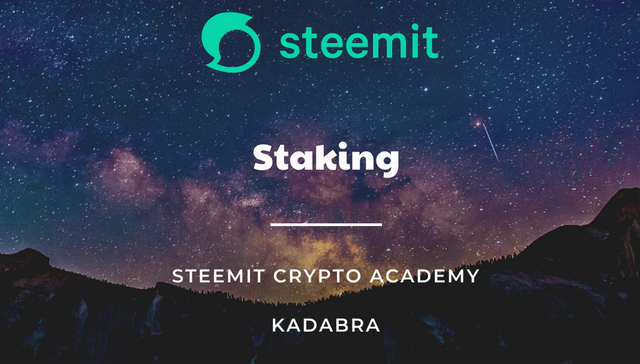Steemit Crypto Academy | Season 3 Week 1 Homework Post for @imagen - Staking
Hello everyone. Our world has been fighting a big epidemic for more than a year. I hope all of you are in good health. Stay healthy!
Today I will share with you the my homework given by the professor @imagen

1-)Research and choose 2 platforms where you can do Staking, explain them, compare them and indicate which one is more profitable according to your opinion. (Binance is not allowed)
Staking is the process of locking a cryptocurrency for a certain period of time without trading or transferring it to another wallet. Depending on the locked time and rate from these locked cryptocurrencies, rewards are earned. In addition to mining, we can say that it is a method of earning crypto money with less resources.
In this homework, I will talk about 2 exchanges platforms that offer staking services.
POLONIEX
Poloniex, which I chose for this homework, is a cryptocurrency exchange founded in 2014 by Tristan D'agosta. Although not among the highest, the volume of the exchange is quite good and has many users.
There is no locking of cryptocurrencies to earn income from staking on this platform. We are free to deposit, withdraw and trade whenever we want.
There are 4 coins on this platform that we can stake and win prizes. These are:
BTT(BitTorrent): There is no staking fee. A minimum of 1000 BTT is required for the reward. A 4-day snapshot of rewards is provided.
ATOM(Cosmos): There is a 25% stake fee. Only a minimum of 1 ATOM is required for the reward. Regular snapshots are provided.
TRX(Tron): There is no staking fee. A minimum of 100 TRX is required for the reward. 4 daily snapshot of rewards is provided.
WINk(WIN): There is no staking fee. A minimum of 5000 WIN is required for the reward. 4 daily snapshot of rewards is provided.
COINBASE

source
Coinbase, which I chose for this homework, is a cryptocurrency exchange founded in 2012 by Brian Armstrong ve Fred Ehrsam. It is currently ranked 3rd among exchanges (according to coinmarketcap) and has a huge volume.
While staking, your coins are locked on this platform and you cannot make any transactions. Also, this service is not available for every country. The number of countries available for this service is very limited. It offers this service for America and a few European countries.
I will talk about 4 coins that can be rewarded by staking on this platform. These are:
ALGO(Algorand): There is a 25% stake fee. A minimum of 0.01 ALGO must be found in the wallet to be eligible for rewards. Stake rewards are paid out daily.
ATOM(Cosmos): There is a 25% stake fee. A minimum of 1 ATOM must be found in the wallet to be eligible for rewards. Stake rewards are paid out every 7 days.
ETH(Ethereum): There is a 25% stake fee. There is no minimum limit. Stake rewards are paid out daily.
XTZ(Tezos): There is a 25% stake fee. A minimum of 1 XTZ must be found in the wallet to be eligible for rewards. Stake rewards are paid out every 3 days.
Poloniex vs Coinbase
I think it is much more profitable to earn rewards by staking on the Poloniex platform. I saw that the Coinbase platform was following a much more restrictive policy. It seemed a little strange that only a few countries offered this service to their citizens. Also, the 25% commission fee from each reward is really too much. If I was going to stake on one of these 2 platforms, it would be poloniex.

2-)What is Impermanent Loss?
The difference between the price of our asset locked in a liquidity pool and the price at the time we lock it is called Impermanent Loss. The greater the difference, the greater the impermanent loss. No matter how much the value of the asset in the liquidity pool drops, as long as we keep the asset there, we will continue to earn rewards and there is always a possibility of becoming profitable. That's why they call these losses as impermanent losses.

3-)What is Delegated Proof of Stake (DPoS)?
DPoS is a consensus mechanism that aims to accelerate the generation and verification of blocks without disrupting the decentralized incentive structure in the blockchain.
In the DPoS protocol, users with assets in the blockchain vote and elect another user as a delegate on their behalf, aiming to achieve consensus. When choosing these delegates, users have as many votes as the assets they have in their wallets. They link the assets they hold in their wallets to a delegate. The asset in their wallet is not transferred, but is recognized as the asset of the delegate they linked.
A certain number of delegates are selected for the blocks created. Delegates selected by users receive transaction fees from verified blocks, and this reward is shared with those who link their assets to the delegate. The more assets tied, the greater the share of the reward.

CONCLUSION
In this homework of Steemit Crypto Academy professor imagen, we learned about staking, impermanent loss and dpos. It's been a good homework for me. I had heard similar things about staking, but I didn't know anything about staking. I learned about such a method of earning by researching. And it piqued my interest. I'm thinking of using this earning method by doing deeper research.
Thanks for reading
CC:
@imagen

Hi @kadabra. Thank you for participating in the Third Season of the Steemit Crypto Academy.
You did a good job and you demonstrate mastery of the topics requested in this assignment, however, you need to show the APY and / or APR rates that each platform offers to users who staking their funds. On the other hand, the remaining questions also lacked information.
Keep pushing yourself and I look forward to correcting your next assignments.
Rating: 6.5
thanks